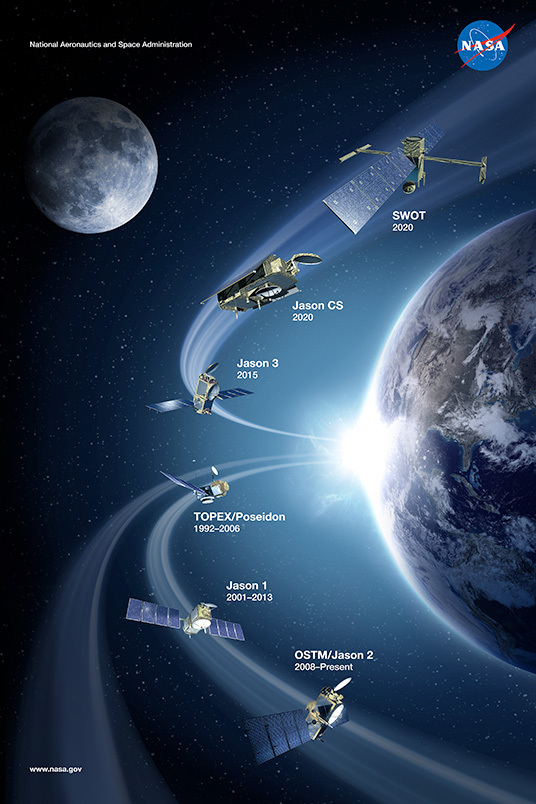Ask NASA Climate | June 4, 2015, 14:08 PDT
Jason-3 and the Argonauts

Artist's concept of NASA's ocean-observing satellite fleet.
Bring out the trumpeters! We’re preparing for another satellite launch. Woohoo! This time it’s Jason-3, an altimetry mission that will observe sea surface topography from space. It’s a legacy mission that continues the 23-year record of global sea level measurements started by TOPEX/Poseidon and carried on by Jason-1 and -2.
When I think of the word “legacy,” I normally become all melancholy ‘n’ stuff, because the word reminds me of what I was doing when those previous satellites went up and of all the people, science and stories that have influenced my life since. So this morning, on my drive to work, I tuned in to a 70s music radio station to funky disco my way out of my melancholy funkiness. (Take that, 80s music heads!)
But no, really, TOPEX/Poseidon was totally cool. (The acronym “TOPEX” comes from “TOPography EXperiment” and Poseidon is the Greek god of the sea; “Jason” is from Jason and the Argonauts, also from Greek mythology.) It launched in 1992 and was the first revolutionary precision oceanography satellite. It transformed the way we study the ocean, because the view from space is the only way to truly observe the vastness of the ocean on a global scale. Since TOPEX/Poseidon began collecting data in 1993, global sea level has risen 80 mm. That’s 3 inches in just over two decades. Holy moly! Now you see why it’s so important to have an uninterrupted stream of satellite data that extends far into the future.
Before TOPEX/Poseidon, there was Seasat, which was designed to find out if global satellite monitoring of Earth’s ocean was even feasible. It launched in 1978 and operated for just over 100 days. And yupity do dah, now we know that satellite observations are feasible.
Just like its predecessors, Jason-3 is a radar altimeter, an instrument that measures sea surface height by precisely knowing the satellite’s position in its orbit and by measuring the distance between itself and the top of the ocean. You see, the ocean surface is constantly changing, from waves, to tides, to El Niño, to sea level rise. As increased global warming causes more and more glacial ice and ice sheets to melt into Earth’s ocean, and as this same warming heats the ocean surface, causing the warmer water to expand and sea levels to rise higher, it’s absolutely crucial to have highly accurate, continuous global sea level measurements.
Furthermore, since the majority of Planet Earth is covered by ocean, and since water is exceptionally good at storing heat, the ocean will continue to play an enormous role in Earth’s long-term climate.
Jason-3 will launch from Vandenberg Air Force Base in July or August. I’ll be keeping you up-to-date on all of the goings on about the launch and its preparation. Meanwhile, you can find out more about Jason-3 and all of NASA's ocean surface topography missions here:
http://sealevel.jpl.nasa.gov/
http://sealevel.jpl.nasa.gov/missions/jason3/
I look forward to your comments.
Laura
Jason-3 is an international partnership led by the National Oceanic and Atmospheric Administration with participation from NASA, France's Centre Nationale d'Etudes Spatiales (the French space agency) and EUMETSAT, the European Organisation for the Exploitation of Meteorological Satellites. JPL built Jason-3's radiometer, GPS and laser reflector; is procuring the launch; and will help oversee the science team, which is responsible for ensuring the quality of the data.
